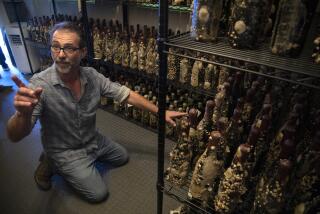Vital Bit of Packaging : He’s on Top of Wine Cork Business
- Share via
SAN RAFAEL, Calif. — If you need a wine cork, Bruce Scott is the man to see. He’s got a nice selection--5 million, more or less--and his family’s business pumps out 340,000 every day.
At Scott Laboratories, about 20 miles north of San Francisco, Scott recently led a visitor past huge sacks stuffed with corks and through rooms where Bunsen burners burned, moisture testers tested and clicking machines stamped names well known to wine lovers on corks by the score.
Although the cork seems to be just another bit of packaging surrounding the important vintage inside the bottle, Scott won’t make light of the vital role the little bit of bark plays in the success of fine wine.
“Inattention to the cork can cause mini-disasters in the corked bottle,” said Scott, vice president of the family company, one of the largest cork importers in the nation.
Slow Process
About 70% of the world’s wine corks come from Portugal, from the cork oak tree. It can take 30 years or more for a cork oak to produce its first harvest, and subsequent harvests come only every eight or nine years thereafter.
Workers use hatchets to strip trees of the cork bark, which is boiled and stripped of rough outer material, aged and drilled to produce corks 1 1/2 inches or 2 inches in length.
Quality bottled wine, Scott points out, wouldn’t even be drinkable without a proper closure. For any batch above the level of “jug” wine, this means corks compressed by machines and rammed into the bottles.
In essence, said Scott, the successful stopper is a workhorse with many duties, all of which must be performed perfectly. Corks are expected to physically touch the wine for years without imparting a flavor or odor, and to prevent leaking of air into the bottle or wine out of it.
Seepage May Be Acceptable
That doesn’t mean, he noted, that a cork showing some seepage on top after the capsule or foil cap is removed automatically means the wine inside is bad. In fact, excellent wines show some seepage on the cork.
The fact, however, is that the enemy of any drinkable wine is air, eventually spoiling even wines hiding behind the most expensive labels.
In addition, corks must be “sterile,” or free of yeast that could begin the fermentation process all over again in the sealed bottle.
Cork sterility does not mean sterility in the medical sense, he said, but “the suitability for being in contact with wines--without wild yeasts which might contaminate the wine in the bottle, or combine with (residual) sugar and grow a colony of its own right on the bottom of the cork.”
Scott Laboratories strives for sterility by using “a combination of heat and sulfur dioxide” and by checking corks for wild yeast by attempting to grow cultures in sugar, the prime food of yeasts.
One cork that doesn’t follow the mold is used to seal champagne bottles. They resemble ordinary corks, but actually are made mostly of chopped, glued cork, with the wine end finished with glued rounds of solid, premium corks.
Since they must withstand great pressure from within, they are designed so the top mushrooms around the opening, and the bottom skirts out inside the neck.
More to Read
Eat your way across L.A.
Get our weekly Tasting Notes newsletter for reviews, news and more.
You may occasionally receive promotional content from the Los Angeles Times.










